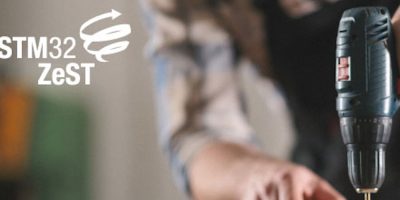ST reveals industry-first embedded software for sensorless zero-speed/high-torque motor control
STMicroelectronics has released the STM32 ZeST (Zero Speed Full Torque) software algorithm, designed to run on STM32 microcontrollers, which lets sensorless motor drives produce full torque at zero speed. The algorithm, now being shared with selected customers, provides this control for the first time in a general-purpose drive, enabling previously unachievable smoothness and predictability.
Equipment such as power tools, rolling shutters, washing machines, auto-mowers, air conditioning systems, and e-bikes need their motors to startup in the right direction with the maximum torque and/or to startup quickly with maximum load, all while consuming the minimum of energy. Ordinary sensorless drives, which cannot determine their rotor position at zero speed, are not suited to meet these requirements. Until now, the solution to ensuring accuracy, high efficiency, and correct operation has typically required adding physical position sensors or using a specific motor type.
The new STM32 ZeST software algorithm is a general-purpose solution that allows optimum sensorless control at zero speed for any kind of permanent magnet synchronous motor (PMSM). To achieve this, the STM32 ZeST algorithm runs in a seamless way with the new High-Sensitivity Observer (HSO) algorithm to control the motor in sensorless mode. As an embedded software solution, no additional hardware or special peripherals in the STM32 microcontroller (MCU) are required. The resistance of the motor is also estimated at run-time to ensure efficient motor control.
Using the STM32 ZeST and HSO software algorithms, designers can improve the energy efficiency of their applications by avoiding high peak current during start-up phases. They can also reduce the bill of materials (BOM), enhance reliability compared to drives containing Hall sensors, and reduce the high acoustic noise. ST has built a demonstration model that shows how a sensorless drive can start-up and move a load at various speeds, down to very low speed. The model, using an e-scooter wheel, shows that the motor always starts in the expected direction and can hold the load at zero speed with no movement.
ST created supporting hardware to evaluate the performance of the STM32 ZeST and HSO algorithms and accelerate the start of development. These include the B-G473E-ZEST1S control board, which generates PWM signals for the power board, STEVAL-LVLP01. This power board drives low-power/low-voltage motors like the one available in ST’s B-MOTOR-PMSMA kit. The control board connects to the power board using the new embedded motor-control connector V2.
ST provides extensive additional support to develop drives for popular motor types to satisfy diverse applications and meet constraints such as energy efficiency, size, performance, and cost. The STM32 microcontroller family covers a broad performance spectrum and many of the devices integrate applicable features such as ST’s advanced motor-control PWM timer. All are supported within the ST motor-control software development kit (MC-SDK), which comprises a motor-control firmware library and dedicated configuration tool (Motor Control Workbench). Both are used with the STM32Cube ecosystem and STM32CubeMX project configurator.
For more information about STM32 motor control and to download the new MCSDK v6.2 including the HSO software algorithm, please visit https://www.st.com/en/embedded-software/x-cube-mcsdk.html




